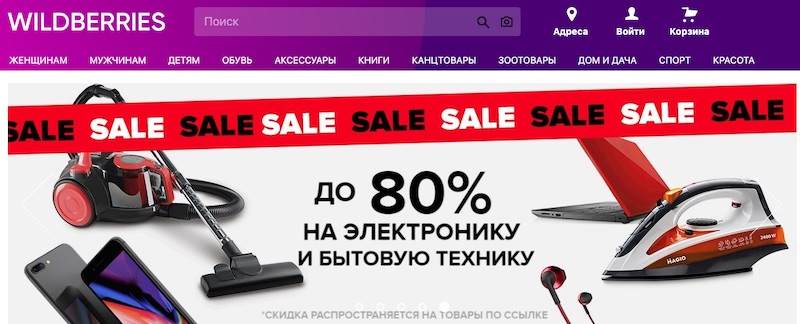
Wildberries has been Russia’s largest online store for three consecutive years. Overall, ecommerce in Russia is growing, albeit slowly.
I last wrote about the Russian ecommerce market in 2014, in “Ecommerce in Russia: Another Emerging Market?,” where I addressed the limited payment options and primitive logistics infrastructure.
Those conditions have gradually improved. Russians now have access to diverse local payment choices. The top domestic marketplaces are building warehouses and increasing their use of technology to improve logistics. New delivery formats have emerged — self-pickup from offices and lockers are popular because they offer online shoppers an alternative to the unreliable Russian Post, the national mail service. Nevertheless, ecommerce sales have grown slowly, reflecting an ailing economy.
Domestic online sales of physical goods are expected to reach $22 billion in 2019, according to Russian research firm Data Insight. Cross-border sales (imported goods) are expected to account for $7 billion this year. This compares to roughly $504 billion domestic U.S. ecommerce sales in 2018, according to Statista.
Purchase Drivers
Russian products have a reputation for poor quality and high prices. More favorable pricing is the primary driver of cross-border ecommerce purchases in Russia. A 2018 survey by Growth from Knowledge (a German research firm) and Yandex.Market (the Russia-based marketplace) found that almost 60 percent of the respondents said they shop online because it is cheaper than offline.
Additional discounts and free delivery are other factors that motivate Russian shoppers, both for domestic and international purchases. The items Russians purchase most frequently online are consumer electronics and apparel and accessories.
Russian consumers aged 25 to 34 years are the most frequent online shoppers.
Domestic Players
The domestic ecommerce market generated $18 billion (including VAT) in physical goods sales in 2018 according to Data Insight. The sales of the top four online retailers combined comprised 27 percent of the total. Similar to 2014, The Russian ecommerce scene remains fragmented, with only the top two domestic market leaders — Wildberries and Citilink — generating more than $1 billion in sales in 2018.
Wildberries, which focuses on fashion items, and DNS-Shop, which sells electronic goods, grew 74 percent and 83 percent respectively in 2018. Wildberries has been Russia’s largest online store for three consecutive years and is expanding into appliances. The company linked the revenue growth to the expansion of its product line and the development of pick-up points. During the first three months of 2019, Wildberries opened 800 new pick-up points, bringing the total number to 3,700. Established in 2004, Wildberries has 15,000 employees.
The Russian ecommerce scene remains fragmented…
Multichannel player Citilink has more than 20 shops in Moscow, and its website specializes in consumer electronics and household appliances.
Ozon, an established player that changed its business model in September 2018 to become a marketplace for other sellers, now has 6,000 merchants. The company had a 73-percent growth rate in 2018 and is investing heavily in its fulfillment capabilities.
Yandex is a large Russian multinational corporation specializing in internet-related products and services, including ecommerce. The Yandex Market Group was established in 2018 as a joint venture by Yandex and state-owned Sberbank, the largest bank in Russia. The group comprises three entities: the Yandex.Market; Beru, another domestic marketplace; and Bringly, an international marketplace that claims over 4 million products and directly competes with AliExpress.
Last month Russian online news provider Bell reported that “Sberbank and Yandex may exit their e-commerce joint venture… while Sberbank may be eyeing another player in the area — Ozon or Avito.” Avito is a classified advertising website, similar to Craigslist. In early 2019 South African internet conglomerate Naspers purchased Avito.
Cross-border Ecommerce
Chinese companies dominate the international market with AliExpress, the huge Alibaba-owned marketplace, being the most successful. Russians also buy from Tmall, another China-based marketplace. Chinese sellers offer the lowest prices, and Russian online shoppers are extremely price sensitive. Orders placed by Russian shoppers on AliExpress are delivered to Russia by authorized shipping partners of Cainiao, the logistics service aggregator of Alibaba Group.
In September 2018 Alibaba allied with Mail.ru Group, a leading Russian internet company. The two partners aim to create an ecosystem that would encompass ecommerce, social communications, and gaming. Additional investors include Russian telco MegaFon and state-owned Russian Direct Investment Fund.
In the past year, Turkish ecommerce merchants have entered the Russian market.
Seventy-three percent of cross-border purchased goods are delivered by Russian Post. Acceptable delivery time for cross-border purchases is about three weeks, according to a Growth from Knowledge 2018 survey. However, consumers in major Russian cities expect delivery in three to five days.
Nonetheless, the cumbersome logistics process in Russia is a barrier to cross-border ecommerce. Many international sellers employ a local logistics partner to navigate the process.
Payments
For domestic purchases, payment on delivery (either by cash or debit card) is still dominant, accounting for 70 percent of ecommerce payments. Other payment options for domestic purchases include the state-supported bank card Mir (which competes with Visa and Mastercard) and e-wallets such as Yandex.One and WebMoney. Payment on delivery is declining, however, due to increased trust in ecommerce and the increased availability of other methods of payment.
For domestic purchases, payment on delivery (either by cash or debit card) is still dominant…
Most foreign sellers do not offer payment on delivery. For international purchases, Russia-based consumers prepay using debit and credit cards or other electronic payment methods.
Apple Pay, Samsung Pay, and Google Pay entered the Russian market in 2016-2017. In 2018, each of these payment methods was used by around 15 percent of online consumers, mostly by smartphone owners in urban areas.
Caveats
Most Russians have modest incomes. The inexpensive Chinese goods sold by AliExpress are especially appealing because of the large assortment and low prices. Often Russian consumers buy goods from AliExpress and resell them on Avito. The grey market is huge, exceeding the official ecommerce market for physical goods several times over.
Starting in January of 2019, Russia lowered the per-person threshold for tax-free purchases from international sellers to €500 from €1,000. Beyond the €500 limit, the government assesses a 30 percent tax. The government is considering lowering the amount again.
The average individual online cross-border purchase was only $25 in 2018, according to the Ecommerce Foundation, a Netherlands-based research firm. The overall domestic average order value was $63.




